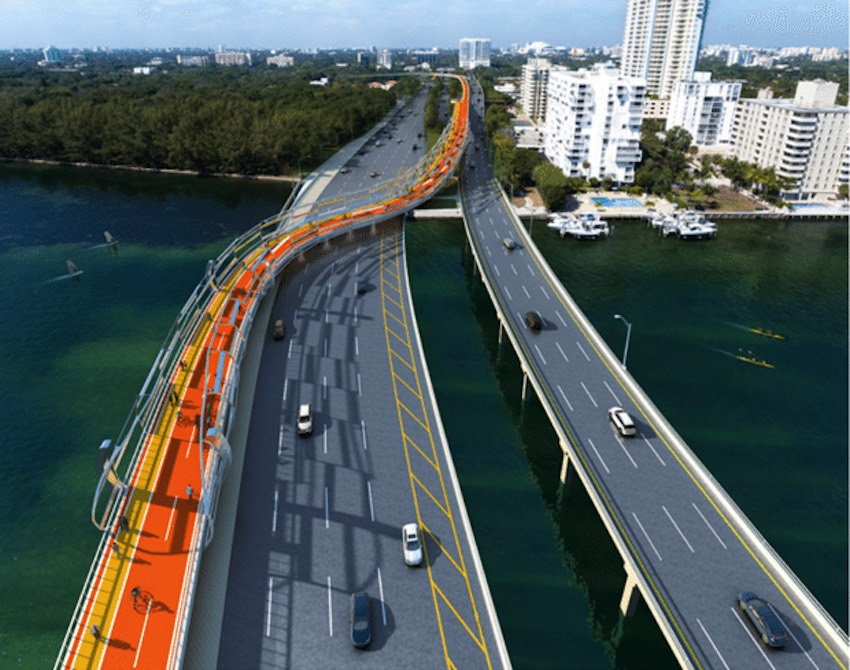Advocates hope this long elevated pathway is just the first step toward changing the city’s bike culture.

The Rickenbacker Causeway makes an apt symbol for Miami’s potential as a city for bike enthusiasts. On the weekends, crowds of cyclists take advantage of the good weather to pedal across the five-mile-long bridge, which boasts idyllic views of the skyscrapers downtown, the islands of Biscayne Bay, and boats sailing to the Atlantic. But, at the same time, the causeway has seen the deaths of at least three cyclists since 2010.
Soon, though, this scenic-but-dangerous thoroughfare could be a symbol of safety and an icon for the cyclists of Miami. Plan Z, a project headed by the architect Bernard Zyscovich, would connect Miami with Key Biscayne via a winding elevated bicycle path, allowing riders to pedal over the cars below, similar to the famous Copenhagen Snake.
Miami is not known as a bicycle-friendly city: It’s listed as the fourth most dangerous city to bike in the U.S.; between 2010 and 2014, 47 people were killed cycling through the city. Florida is the state with most cyclist fatalities per capita in United States (the situation is just as bleak for pedestrians).
From our partners:
“Very simply, if we don’t have safe infrastructure, we are not going to get people to bike.”
Zyscovich thinks that Plan Z can kickstart a cultural change in the city. The project could join two other proposed infrastructure projects, a linear park called the Underline and the Ludlam Trail, a rails-to-trail multi-use path. “I think that what we are presenting is a concept large enough to contribute to creating a network,” the architect says. “If we can implement Plan Z, the Underline, and the Ludlam Trail, we are going to have thousands of users that will then become the advocacy group to demand more bicycle infrastructure.”
Can such a signature megaproject change the mentality of a place that has for decades prioritized the use of cars? Danish mobility consultant Mikael Colville-Andersen, who was recently in Miami for the launch of Plan Z, says that the city can definitely improve its relationship with bicycling, as others in the U.S. have done. But the change might not depend on something as big and oriented to recreational use as Plan Z.

“I think it is iconic and visionary and pretty awesome if they can build that, but it really isn’t for [daily] transport,” Colville-Andersen says. “But maybe that is what it takes. Maybe this is what Miami needs—just this crazy thing as a way of encouraging the city to do more.”
Colville-Andersen’s consulting firm—the Copenhagenize Design Company—participated in the design of a recreational path similar to Plan Z, a 23.5 kilometer path around an airport in Bangkok. “My hope working on that project was that it was going to help inspire the city to do more for cycling. It didn’t happen, but maybe it’s going to happen here,” says Colville-Andersen, who is also assisting Detroit and Long Beach in becoming more bike-friendly cities. Based on past experiences, however, he seem skeptical of the notion that Plan Z will get more transportation-oriented riders to hit the streets. “We’ve looked at 70 years of history in our company, looking for examples of sport and recreational [biking] inspiring the 99 percent to ride to work, and there is nothing. We have no historical record of this, because it is apples and oranges.”
It’s necessary to clarify that Plan Z isn’t just a bike path, although that’s perhaps the most striking part of the proposal. As Zyscovich explains, the Rickenbacker Causeway urgently needs structural renovations, including more elevation to help it survive climate change. “There is sea level rise, there is the replacement of the bridge, there is a 20-acre new park,” says the architect. “The bicycle aspect is only one part of the bigger project. But bicycle safety is the basis for beginning to think about it.”

Meg Daly, the founder of the Underline project—a large citizen initiative that will create pedestrian paths and bicycle paths under Miami’s elevated urban train—agrees that the safety benefits could help convince politicians and sway public opinion on the matter of biking. “I think that very simply if we don’t have safe infrastructure, we are not going to get people to bike,” Daly says. “We have a great economic impact report for our project talking about improving property value, new jobs, all that stuff. But you present it to a politician, they say, ‘We have to focus on safety.’”
On that front, Miami can clearly do much more, such as speed limit reductions and better traffic law enforcement. Establishing a better network of standard bike lanes on surface streets would also help: The city’s existing bike infrastructure has been described, generously, as “pathetic.” But to do that, you have to win over local politicians. And, for them, a flashy snake-shaped bike highway in the sky might just look better. Additional reading.
This feature originally appeared in Citylab.
















